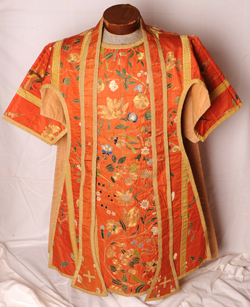
Special Collections oversees the university museum collection. The first donations of museum items date to before the school opened in 1889. Up until 1905 the collection was displayed in Caldwell Hall. Starting in 1905 and continuing until 1976 parts of the collection were either displayed in McMahon Hall or Mullen Library, or were put into storage. In 1976 the university museum collection was put under the management of the Archives and the collection was housed in Curley Hall vault, with items being used in campus exhibition or loaned to campus offices to be displayed and enjoyed as office decoration.
- The university museum collection comprises several distinct collections, the Anthropology Collection, the Magner Collection, the New Museum Collection, and the Coin Collection.
- Detailed history of the museum collection
- An online inventory of the museum Collections can be accessed and searched at the Library's Museum Objects catalog
Please contact the archives at lib-archives@cua.edu with any questions regarding the museum collection.
Collecting Policies
Collecting Scope
For the Museum Collections, the Special Collections of The Catholic University of America actively collects physical artifacts of permanent value that document the history of the Catholic University community, the history of Catholics in the United States, the history of the Brookland neighborhood, examples of Catholic devotional and liturgical art from across the world, and/or objects that fulfill the educational mission of the Catholic University and supplement the archival, manuscript, and rare books departments of Special Collections.
The Museum Collections also includes fine art objects that are donated into the care of the University by outside organizations, alumni, and private individuals.
The collection also includes examples of nineteenth- and twentieth-century anthropological artifacts. Currently, we do not actively collect further anthropological artifacts.
Acquisition Process
Through donation, purchase, or exchange, we collect historical artifacts in support of our collecting priorities and in complement to the educational mission of Catholic University of America.
Our staff consider several factors in determining acquisitions. This included, but is not limited to: our institutional collecting priorities and educational mission; historical or artistic merit; research value; promotional potential (exhibits and more); maintenance and conservation cost; and provenance (the documented ownership history of a piece).
All acquisitions are subject to United States law, Catholic University policies, and professional best practices.
If you are interested in donating to the collection, please contact the Special Collections staff.
Examples of the Museum Collections:
Art and Artifacts
- Paintings dating from the 16th century (16th - 17th century).
- Large carved statues and terra cotta works from China, Japan, France, and Italy (13th - 17th century).
- Carved ivories, statues, shrines, diptychs, and triptychs (16th - 19th century Europe).
- Asian objects d'art, such as vases, urns, and plates (16th - 20th century).
- Coin collection from the Classical world, Ancient Near East, and Europe (400 B.C. - 20th century).
- Prints, lithographs, and engravings: varied prints (18th - 20th century).
- Modern works by Gene Davis, I. Rice Pereira, Steven Saklarian, and others.
- Varied decorative arts, and Asian and European furniture.
History
- Portraits and busts of important American and religious figures and those who played important roles in the development of Catholic University.
- Artifacts relating to the founding and the history of the University.
- Catholic devotional and liturgical objects from Europe and America (19th - early 20th century).
Anthropology
- Archaeological artifacts from the Ancient Near East and the Classical and pre-Columbian world (2000 B.C. - A.D. 200).
- Implements, pottery, and other artifacts from Native Americans of North America; People of South, Central, and Latin America; and People of Africa, Polynesia, and the Philippines (18th - early 20th century).
- Ethnographic and archeological artifacts from Samoa, Africa, the Philippines, and North America (19th - 20th century).
